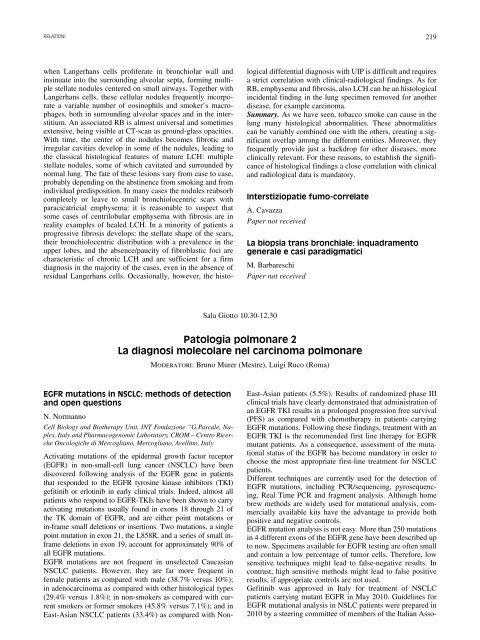Sabato 27 ottobre 2012 - Pacini Editore
Sabato 27 ottobre 2012 - Pacini Editore
Sabato 27 ottobre 2012 - Pacini Editore
Create successful ePaper yourself
Turn your PDF publications into a flip-book with our unique Google optimized e-Paper software.
RElaziONi<br />
when Langerhans cells proliferate in bronchiolar wall and<br />
insinuate into the surrounding alveolar septa, forming multiple<br />
stellate nodules centered on small airways. Together with<br />
Langerhans cells, these cellular nodules frequently incorporate<br />
a variable number of eosinophils and smoker’s macrophages,<br />
both in surrounding alveolar spaces and in the interstitium.<br />
An associated RB is almost universal and sometimes<br />
extensive, being visible at CT-scan as ground-glass opacities.<br />
With time, the center of the nodules becomes fibrotic and<br />
irregular cavities develop in some of the nodules, leading to<br />
the classical histological features of mature LCH: multiple<br />
stellate nodules, some of which cavitated and surrounded by<br />
normal lung. The fate of these lesions vary from case to case,<br />
probably depending on the abstinence from smoking and from<br />
individual predisposition. In many cases the nodules reabsorb<br />
completely or leave to small bronchiolocentric scars with<br />
paracicatricial emphysema: it is reasonable to suspect that<br />
some cases of centrilobular emphysema with fibrosis are in<br />
reality examples of healed LCH. In a minority of patients a<br />
progressive fibrosis develops: the stellate shape of the scars,<br />
their bronchiolocentric distribution with a prevalence in the<br />
upper lobes, and the absence/paucity of fibroblastic foci are<br />
characteristic of chronic LCH and are sufficient for a firm<br />
diagnosis in the majority of the cases, even in the absence of<br />
residual Langerhans cells. Occasionally, however, the histo-<br />
Sala Giotto 10.30-12.30<br />
Patologia polmonare 2<br />
La diagnosi molecolare nel carcinoma polmonare<br />
EGFr mutations in nSCLC: methods of detection<br />
and open questions<br />
N. Normanno<br />
Cell Biology and Biotherapy Unit, INT Fondazione “G.Pascale, Naples,<br />
Italy and Pharmacogenomic Laboratory, CROM – Centro Ricerche<br />
Oncologiche di Mercogliano, Mercogliano, Avellino, Italy<br />
Activating mutations of the epidermal growth factor receptor<br />
(EGFR) in non-small-cell lung cancer (NSCLC) have been<br />
discovered following analysis of the EGFR gene in patients<br />
that responded to the EGFR tyrosine kinase inhibitors (TKI)<br />
gefitinib or erlotinib in early clinical trials. Indeed, almost all<br />
patients who respond to EGFR-TKIs have been shown to carry<br />
activating mutations usually found in exons 18 through 21 of<br />
the TK domain of EGFR, and are either point mutations or<br />
in-frame small deletions or insertions. Two mutations, a single<br />
point mutation in exon 21, the L858R, and a series of small inframe<br />
deletions in exon 19, account for approximately 90% of<br />
all EGFR mutations.<br />
EGFR mutations are not frequent in unselected Caucasian<br />
NSCLC patients. However, they are far more frequent in<br />
female patients as compared with male (38.7% versus 10%);<br />
in adenocarcinoma as compared with other histological types<br />
(29.4% versus 1.8%); in non-smokers as compared with current<br />
smokers or former smokers (45.8% versus 7.1%); and in<br />
East-Asian NSCLC patients (33.4%) as compared with Non-<br />
Moderatori: Bruno Murer (Mestre), Luigi Ruco (Roma)<br />
219<br />
logical differential diagnosis with UIP is difficult and requires<br />
a strict correlation with clinical-radiological findings. As for<br />
RB, emphysema and fibrosis, also LCH can be an histological<br />
incidental finding in the lung specimen removed for another<br />
disease, for example carcinoma.<br />
Summary. As we have seen, tobacco smoke can cause in the<br />
lung many histological abnormalities. These abnormalities<br />
can be variably combined one with the others, creating a significant<br />
overlap among the different entities. Moreover, they<br />
frequently provide just a backdrop for other diseases, more<br />
clinically relevant. For these reasons, to establish the significance<br />
of histological findings a close correlation with clinical<br />
and radiological data is mandatory.<br />
Interstiziopatie fumo-correlate<br />
A. Cavazza<br />
Paper not received<br />
La biopsia trans bronchiale: inquadramento<br />
generale e casi paradigmatici<br />
M. Barbareschi<br />
Paper not received<br />
East-Asian patients (5.5%). Results of randomized phase III<br />
clinical trials have clearly demonstrated that administration of<br />
an EGFR TKI results in a prolonged progression free survival<br />
(PFS) as compared with chemotherapy in patients carrying<br />
EGFR mutations. Following these findings, treatment with an<br />
EGFR TKI is the recommended first line therapy for EGFR<br />
mutant patients. As a consequence, assessment of the mutational<br />
status of the EGFR has become mandatory in order to<br />
choose the most appropriate first-line treatment for NSCLC<br />
patients.<br />
Different techniques are currently used for the detection of<br />
EGFR mutations, including PCR/sequencing, pyrosequencing,<br />
Real Time PCR and fragment analysis. Although home<br />
brew methods are widely used for mutational analysis, commercially<br />
available kits have the advantage to provide both<br />
positive and negative controls.<br />
EGFR mutation analysis is not easy. More than 250 mutations<br />
in 4 different exons of the EGFR gene have been described up<br />
to now. Specimens available for EGFR testing are often small<br />
and contain a low percentage of tumor cells. Therefore, low<br />
sensitive techniques might lead to false-negative results. In<br />
contrast, high sensitive methods might lead to false positive<br />
results, if appropriate controls are not used.<br />
Gefitinib was approved in Italy for treatment of NSCLC<br />
patients carrying mutant EGFR in May 2010. Guidelines for<br />
EGFR mutational analysis in NSLC patients were prepared in<br />
2010 by a steering committee of members of the Italian Asso-







